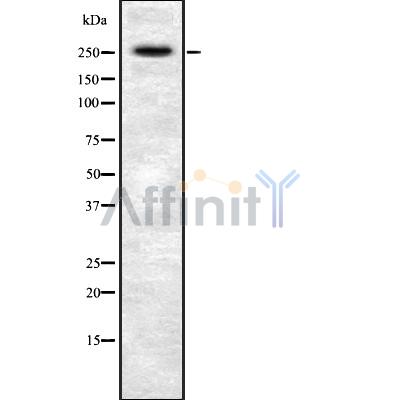AKAP6 Antibody - #DF8820
| Product: | AKAP6 Antibody |
| Catalog: | DF8820 |
| Description: | Rabbit polyclonal antibody to AKAP6 |
| Application: | WB IHC IF/ICC |
| Reactivity: | Human, Mouse |
| Prediction: | Pig, Dog |
| Mol.Wt.: | 257kDa; 257kD(Calculated). |
| Uniprot: | Q13023 |
| RRID: | AB_2842017 |
Product Info
*The optimal dilutions should be determined by the end user. For optimal experimental results, antibody reuse is not recommended.
*Tips:
WB: For western blot detection of denatured protein samples. IHC: For immunohistochemical detection of paraffin sections (IHC-p) or frozen sections (IHC-f) of tissue samples. IF/ICC: For immunofluorescence detection of cell samples. ELISA(peptide): For ELISA detection of antigenic peptide.
Cite Format: Affinity Biosciences Cat# DF8820, RRID:AB_2842017.
Fold/Unfold
A kinase (PRKA) anchor protein 6; A kinase anchor protein 100; A kinase anchor protein 100 kDa; A kinase anchor protein 6; ADAP 100; ADAP 6; ADAP100; ADAP6; AKAP 100; AKAP 6; AKAP100; Human A kinase anchor protein AKAP100; KIAA0311; mAKAP; PRKA 6; PRKA6; Protein kinase A anchoring protein 6;
Immunogens
A synthesized peptide derived from human AKAP6, corresponding to a region within C-terminal amino acids.
- Q13023 AKAP6_HUMAN:
- Protein BLAST With
- NCBI/
- ExPASy/
- Uniprot
MLTMSVTLSPLRSQDLDPMATDASPMAINMTPTVEQGEGEEAMKDMDSDQQYEKPPPLHTGADWKIVLHLPEIETWLRMTSERVRDLTYSVQQDSDSKHVDVHLVQLKDICEDISDHVEQIHALLETEFSLKLLSYSVNVIVDIHAVQLLWHQLRVSVLVLRERILQGLQDANGNYTRQTDILQAFSEETKEGRLDSLTEVDDSGQLTIKCSQNYLSLDCGITAFELSDYSPSEDLLSGLGDMTSSQVKTKPFDSWSYSEMEKEFPELIRSVGLLTVAADSISTNGSEAVTEEVSQVSLSVDDKGGCEEDNASAVEEQPGLTLGVSSSSGEALTNAAQPSSETVQQESSSSSHHDAKNQQPVPCENATPKRTIRDCFNYNEDSPTQPTLPKRGLFLKEETFKNDLKGNGGKRQMVDLKPEMSRSTPSLVDPPDRSKLCLVLQSSYPNSPSAASQSYECLHKVGNGNLENTVKFHIKEISSSLGRLNDCYKEKSRLKKPHKTSEEVPPCRTPKRGTGSGKQAKNTKSSAVPNGELSYTSKAIEGPQTNSASTSSLEPCNQRSWNAKLQLQSETSSSPAFTQSSESSVGSDNIMSPVPLLSKHKSKKGQASSPSHVTRNGEVVEAWYGSDEYLALPSHLKQTEVLALKLENLTKLLPQKPRGETIQNIDDWELSEMNSDSEIYPTYHVKKKHTRLGRVSPSSSSDIASSLGESIESGPLSDILSDEESSMPLAGMKKYADEKSERASSSEKNESHSATKSALIQKLMQDIQHQDNYEAIWEKIEGFVNKLDEFIQWLNEAMETTENWTPPKAEMDDLKLYLETHLSFKLNVDSHCALKEAVEEEGHQLLELIASHKAGLKDMLRMIASQWKELQRQIKRQHSWILRALDTIKAEILATDVSVEDEEGTGSPKAEVQLCYLEAQRDAVEQMSLKLYSEQYTSSSKRKEEFADMSKVHSVGSNGLLDFDSEYQELWDWLIDMESLVMDSHDLMMSEEQQQHLYKRYSVEMSIRHLKKTELLSKVEALKKGGVLLPNDLLEKVDSINEKWELLGKTLGEKIQDTMAGHSGSSPRDLLSPESGSLVRQLEVRIKELKGWLRDTELFIFNSCLRQEKEGTMNTEKQLQYFKSLCREIKQRRRGVASILRLCQHLLDDRETCNLNADHQPMQLIIVNLERRWEAIVMQAVQWQTRLQKKMGKESETLNVIDPGLMDLNGMSEDALEWDEMDISNKLISLNEESNDLDQELQPVIPSLKLGETSNEDPGYDEEADNHGGSQYASNITAPSSPHIYQVYSLHNVELYEDNHMPFLKNNPKVTGMTQPNVLTKSLSKDSSFSSTKSLPDLLGGSNLVKPCACHGGDMSQNSGSESGIVSEGDTETTTNSEMCLLNAVDGSPSNLETEHLDPQMGDAVNVLKQKFTDEGESIKLPNSSQSSISPVGCVNGKVGDLNSITKHTPDCLGEELQGKHDVFTFYDYSYLQGSKLKLPMIMKQSQSEKAHVEDPLLRGFYFDKKSCKSKHQTTELQPDVPPHERILASASHEMDRISYKSGNIEKTFTGMQNAKQLSLLSHSSSIESLSPGGDLFGLGIFKNGSDSLQRSTSLESWLTSYKSNEDLFSCHSSGDISVSSGSVGELSKRTLDLLNRLENIQSPSEQKIKRSVSDITLQSSSQKMSFTGQMSLDIASSINEDSAASLTELSSSDELSLCSEDIVLHKNKIPESNASFRKRLTRSVADESDVNVSMIVNVSCTSACTDDEDDSDLLSSSTLTLTEEELCIKDEDDDSSIATDDEIYEDCTLMSGLDYIKNELQTWIRPKLSLTRDKKRCNVSDEMKGSKDISSSEMTNPSDTLNIETLLNGSVKRVSENNGNGKNSSHTHELGTKRENKKTIFKVNKDPYVADMENGNIEGIPERQKGKPNVTSKVSENLGSHGKEISESEHCKCKALMDSLDDSNTAGKEFVSQDVRHLPKKCPNHHHFENQSTASTPTEKSFSELALETRFNNRQDSDALKSSDDAPSMAGKSAGCCLALEQNGTEENASISNISCCNCEPDVFHQKDAEDCSVHNFVKEIIDMASTALKSKSQPENEVAAPTSLTQIKEKVLEHSHRPIQLRKGDFYSYLSLSSHDSDCGEVTNYIEEKSSTPLPLDTTDSGLDDKEDIECFFEACVEGDSDGEEPCFSSAPPNESAVPSEAAMPLQATACSSEFSDSSLSADDADTVALSSPSSQERAEVGKEVNGLPQTSSGCAENLEFTPSKLDSEKESSGKPGESGMPEEHNAASAKSKVQDLSLKANQPTDKAALHPSPKTLTCEENLLNLHEKRHRNMHR
Predictions
Score>80(red) has high confidence and is suggested to be used for WB detection. *The prediction model is mainly based on the alignment of immunogen sequences, the results are for reference only, not as the basis of quality assurance.
High(score>80) Medium(80>score>50) Low(score<50) No confidence
Research Backgrounds
Binds to type II regulatory subunits of protein kinase A and anchors/targets them to the nuclear membrane or sarcoplasmic reticulum. May act as an adapter for assembling multiprotein complexes.
Sarcoplasmic reticulum. Nucleus membrane.
Note: In heart muscle. Participation of multiple targeting signals allow correct intracellular targeting. These may be repeated motifs rich in basic and hydrophobic amino acids, palmitoylated/myristoylated motifs or alternatively splice targeting sequences.
Highly expressed in cardiac and skeletal muscle, followed by brain.
RII-alpha binding site, predicted to form an amphipathic helix, could participate in protein-protein interactions with a complementary surface on the R-subunit dimer.
Restrictive clause
Affinity Biosciences tests all products strictly. Citations are provided as a resource for additional applications that have not been validated by Affinity Biosciences. Please choose the appropriate format for each application and consult Materials and Methods sections for additional details about the use of any product in these publications.
For Research Use Only.
Not for use in diagnostic or therapeutic procedures. Not for resale. Not for distribution without written consent. Affinity Biosciences will not be held responsible for patent infringement or other violations that may occur with the use of our products. Affinity Biosciences, Affinity Biosciences Logo and all other trademarks are the property of Affinity Biosciences LTD.

